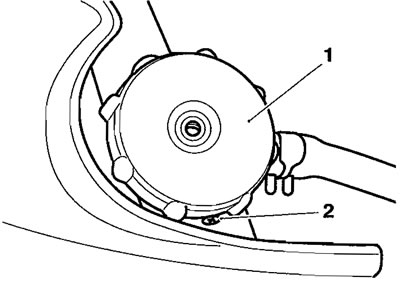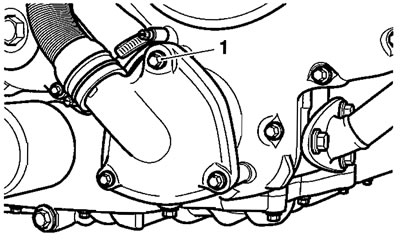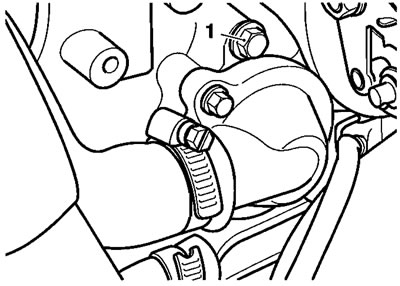Drainage
Warning! Do not remove the coolant pressure cap when the engine is hot. When the engine is hot, the coolant inside the radiator is hot and also under pressure. Contact with hot coolant will cause scalds and skin damage.
Warning! Before starting work, ensure the motorcycle is stabilised and adequately supported. This will help prevent it from falling and causing injury to the operator or damage to the motorcycle.
1. Remove the left hand radiator cover.

1. Radiator cover
2. Release the security screw and remove the coolant pressure cap on the radiator.

1. Radiator cap; 2. Security screw
3. Position a container beneath the water pump to collect the displaced coolant.
4. Detach the bottom hose from the water pump and allow the coolant to drain out.
Note: To facilitate full drain out, also remove the drain plug from the water pump.

1. Water pump drain plug
Filling
1. If removed, refit the water pump drain plug. Tighten the plug to 10 Nm.
2. Reconnect the bottom hose and tighten the clip.
3. Open the cooling system bleed screw.

1. Bleed screw
4. Slowly add coolant mixture to the system, through the filler opening in the radiator, until coolant escapes from the bleed screw. Close the bleed screw, tightening it to 10 Nm.
5. If necessary, top up the system through the radiator filler.
6. Refit the pressure cap.
7. Start the motorcycle and allow the engine to idle for a short period of time to allow any air to be expelled from the system.
Warning! Do not remove the coolant pressure cap when the engine is hot. When the engine is hot, the coolant inside the cooling system is hot and also under pressure. Contact with hot coolant will cause scalds and skin damage.
8. Stop the engine and top up the coolant level as necessary.
9. Refit the coolant pressure cap and tighten the security screw to 3 Nm.
10. Refit the left hand radiator cover, tightening the fixings to 3 Nm.
11. Check the expansion tank level and top up if necessary (see page 12.5).
